You’re Still Your Child’s Hero, And The Connection They Crave The Most.
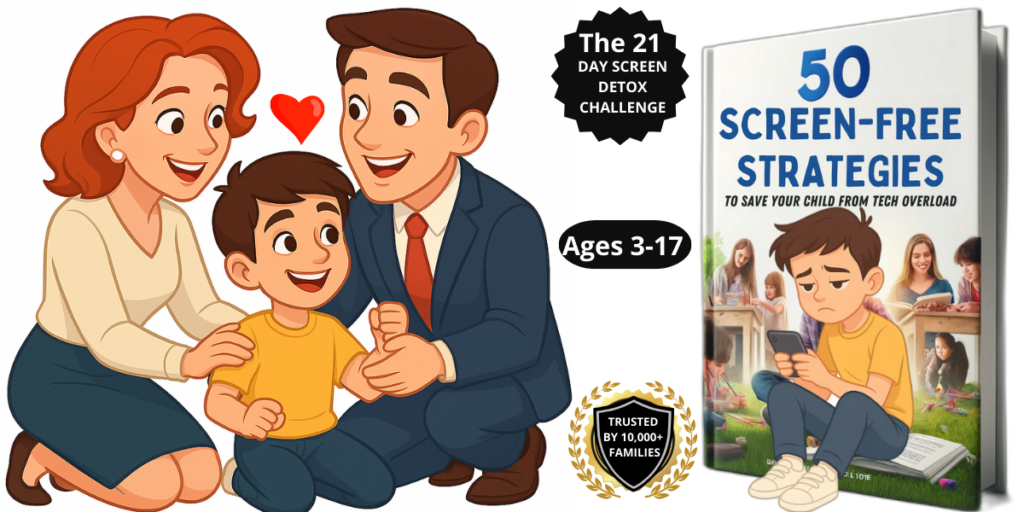
Disconnect them from screens. Reconnect them to you.
The 21-Day Screen Detox Plan That Has Already Reconnected Over 10,000 Families — Without yelling, threats or punishments.
90% Of Parents Report a Real Difference in Under 5 Days.
Backed by leading child-development professionals, this 21-Day Screen Detox Approach reduces screen overuse, improves behavior and mood, and helps rebuild the emotional connection kids need most.
Real Results. Real Stories. From Parents Like You.


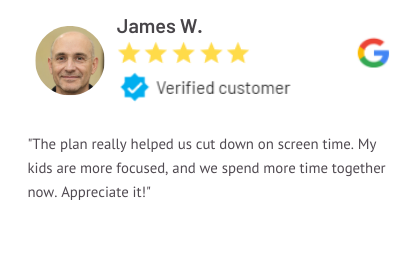
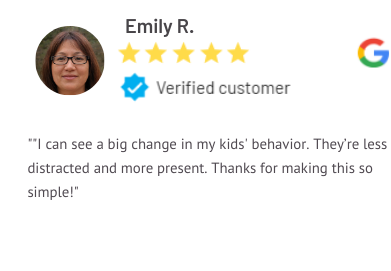
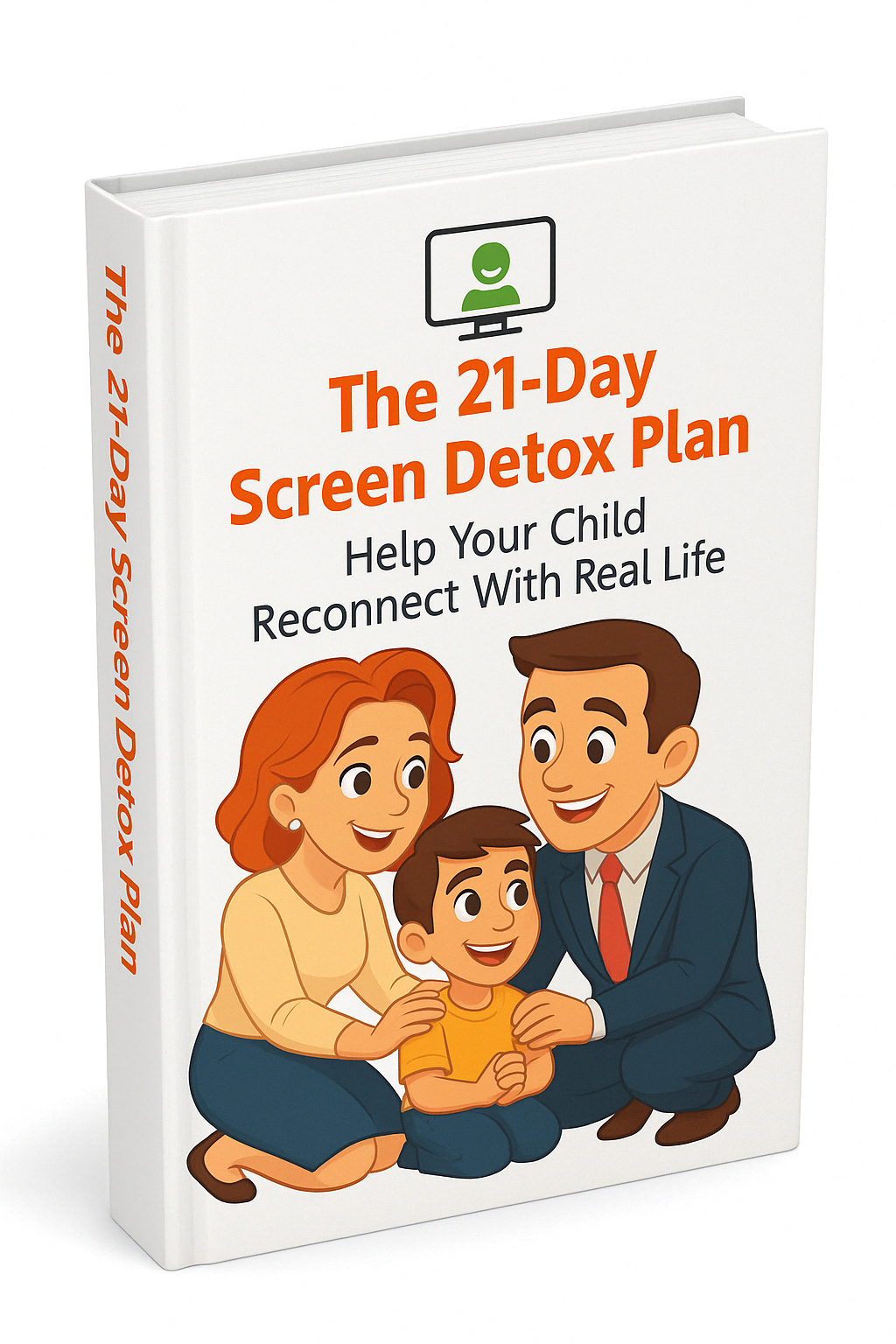
🎁 What You’re Getting Today
✅ The 21-Day Screen Detox Plan
A complete, step-by-step guide to help your child reset screen habits and rebuild emotional connection with you — in just 3 weeks.
✅ Real-Life Scripts for Calm Conversations
Tested phrases that help you respond calmly when your child resists limits — even in real-life tough moments.
✅ The 50 Screen-Free Swaps Playbook
Your go-to rescue tool for moments when your child says: "There’s nothing else to do!" Packed with creative, screen-free alternatives that work — even when you're tired or out of ideas.
✅ Printable Visual Tools + Charts
Behavior charts, visual agreements, and fun guides to help kids stay engaged during the process.
✅ Positive Parenting Shortcuts
Bite-sized tips and calming strategies to create smoother routines, fewer meltdowns, and more cooperation.
✅ Lifetime Access + Free Updates
Revisit the plan anytime — and receive future updates automatically, forever.
Includes the full 21-day program + all 5 exclusive bonuses
What Is the 21-Day Screen Detox Plan?
Countless studies confirm that excessive screen time increases anxiety, attention issues, and emotional disconnection in kids.
Big tech companies design apps to keep children hooked — using colors, sounds, and fast-moving visuals to capture their brains and block self-regulation.
That’s why your child might resist every time you try to take away a device — it’s not just habit, it’s design.
The worst part? The damage doesn’t show up immediately. Most parents only realize what’s happening when it starts affecting their child’s mood, focus, sleep, and social life.
Problems like restlessness, aggression, apathy, weight gain, and lack of real-world connection often begin silently — and grow fast.
The 21-Day Screen Detox Plan was created to reverse that trend — quickly and calmly.
In just 3 weeks, you’ll help your child:
- Reduce screen time without conflict
- Break harmful screen habits gently
- Protect their focus, creativity, and emotional health
- Reconnect with real life: play, friends, imagination
And you’ll do it without:
- Harsh punishments or guilt
- Eliminating all screens overnight
- Using confusing tech controls you don’t understand
- Damaging trust between you and your child
Instead, you'll follow a clear, step-by-step plan — built for real, busy parents — to restore balance and bring peace back into your home.
This is more than a digital detox.
It’s a path back to the child you know and love.
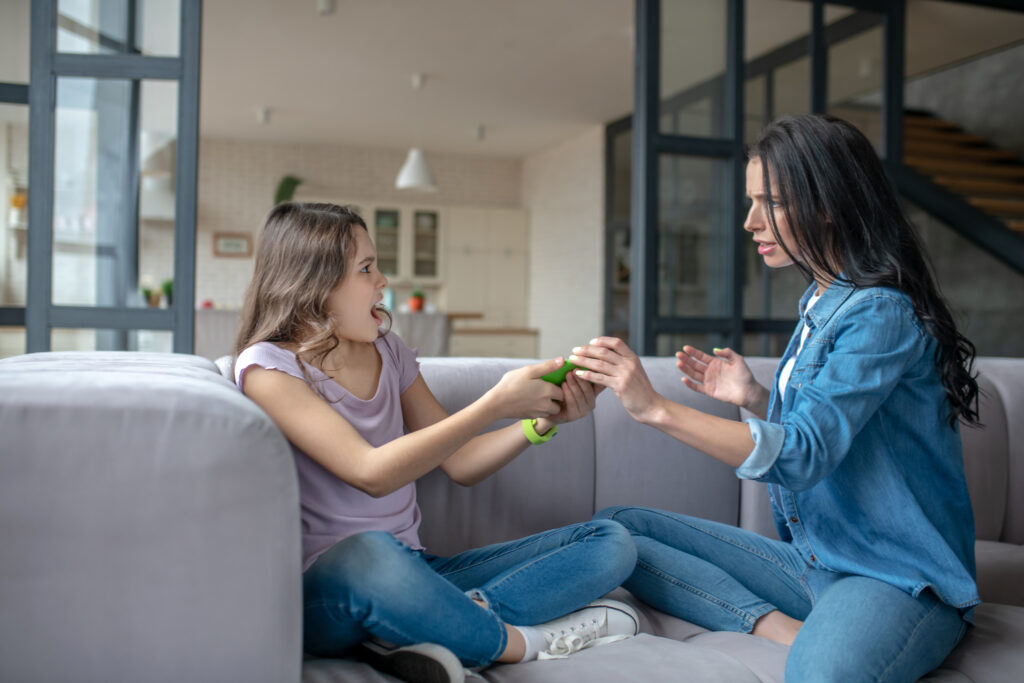
The Numbers Don’t Lie
Recent studies reveal that screen time is reshaping our children’s brains, behavior, and development. These numbers speak for themselves — and every parent needs to see them.
85% of brain growth happens by age 3
Excessive screen exposure during this time can interfere with emotional and cognitive development.
📱 48% of kids under 8 have their own tablet
This early access to screens can delay language skills and reduce face-to-face interactions — essential for social development.
👀 Kids spend an average of 7+ hours on screens daily
This replaces outdoor play, reading, and bonding time with family — leading to attention issues and isolation.
🧠 1 in 3 children show signs of screen addiction
Constant stimulation and dopamine spikes from screens are rewiring their developing brains — making it harder to focus and self-regulate.
💢 Behavioral problems have increased by 200%
Since screen exposure has grown, issues like aggression, hyperactivity, and sleep disruption have become more common in children.
🧩 Only 1 in 5 parents feel in control of screen time
Many feel overwhelmed, unsure how to set limits or replace screens with healthy, engaging alternatives.
Here’s Your Day-by-Day Transformation Plan
See the Real Value of Everything You’re Getting Today
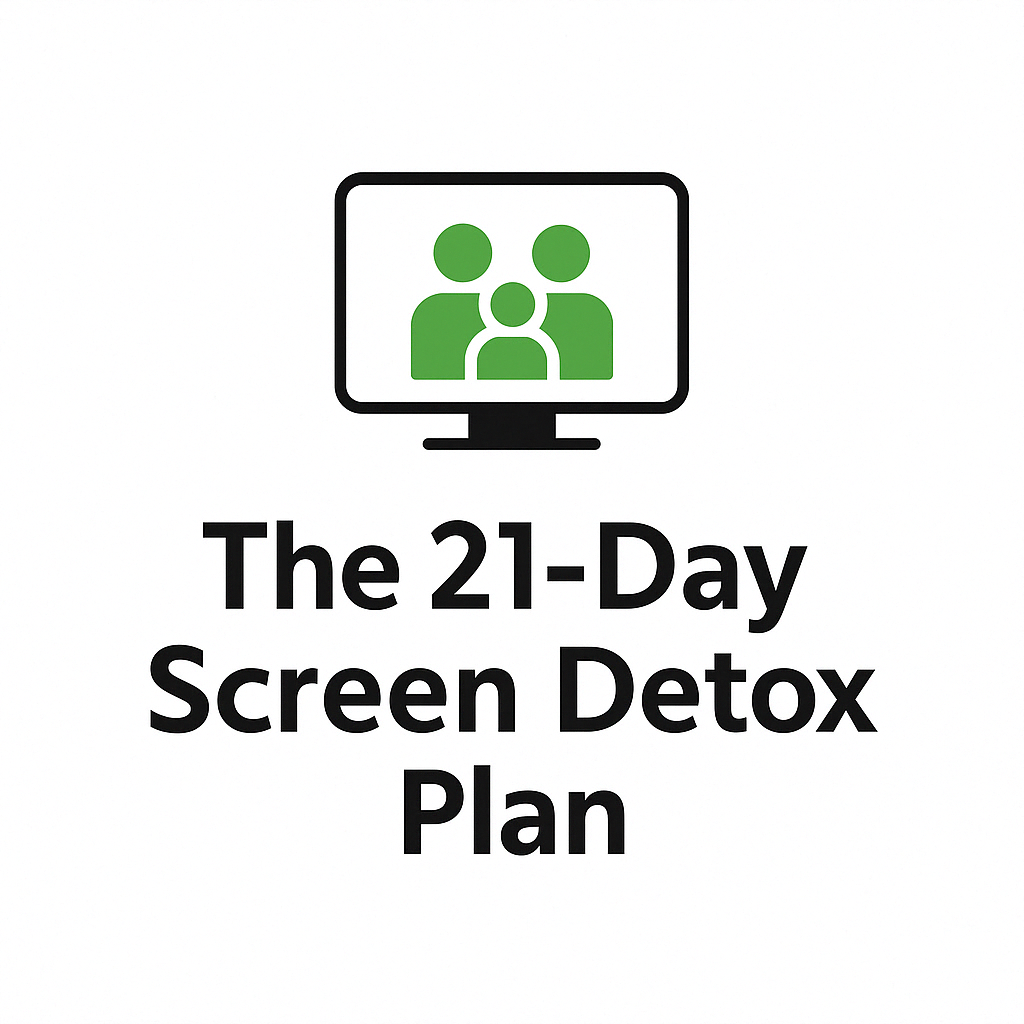
The 21-Day Screen Detox Plan
A simple, powerful system to reset your child’s screen habits in just 3 weeks.
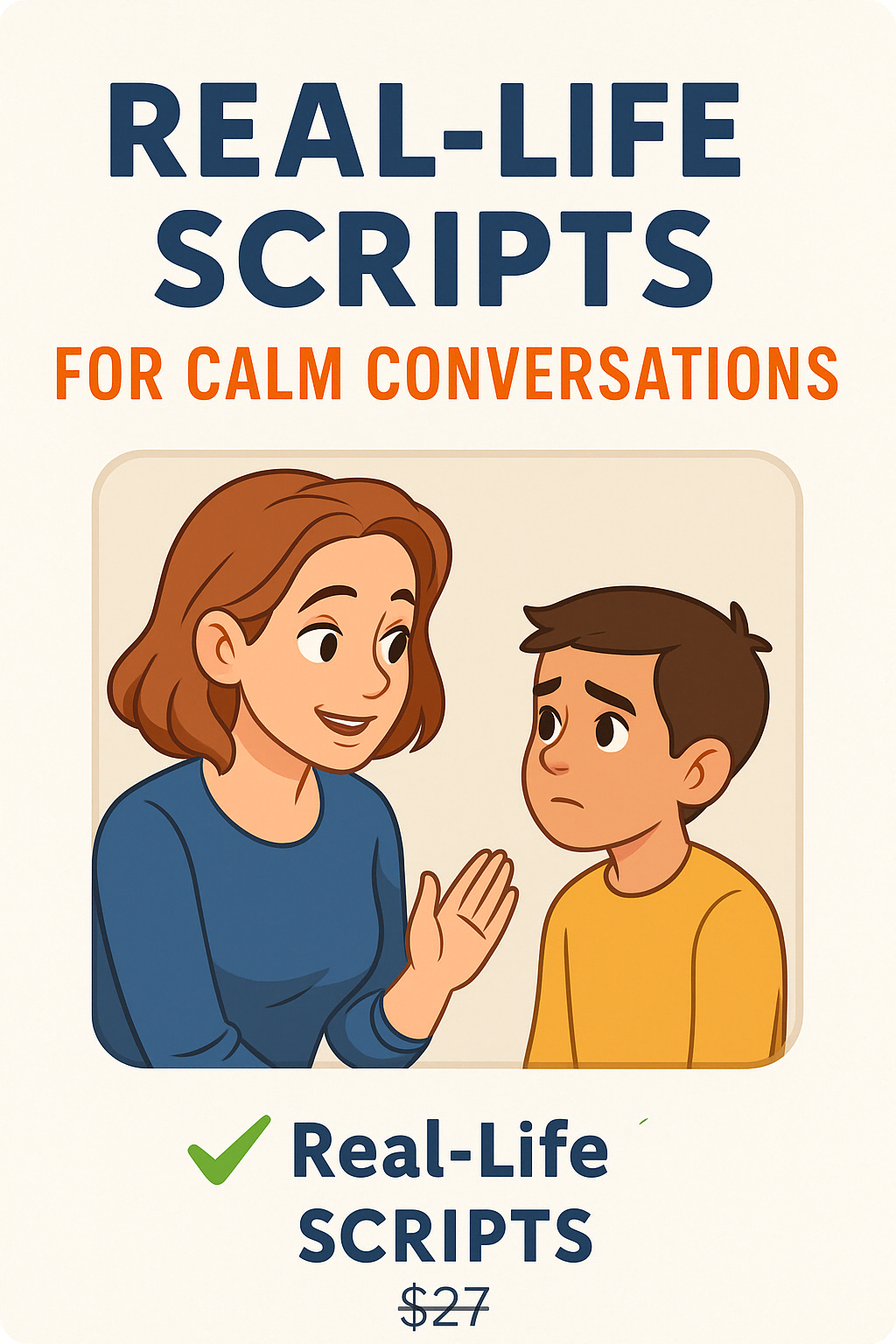
Real-Life Scripts for Calm Conversations
Phrases tested by real parents — so you know exactly what to say (and how).
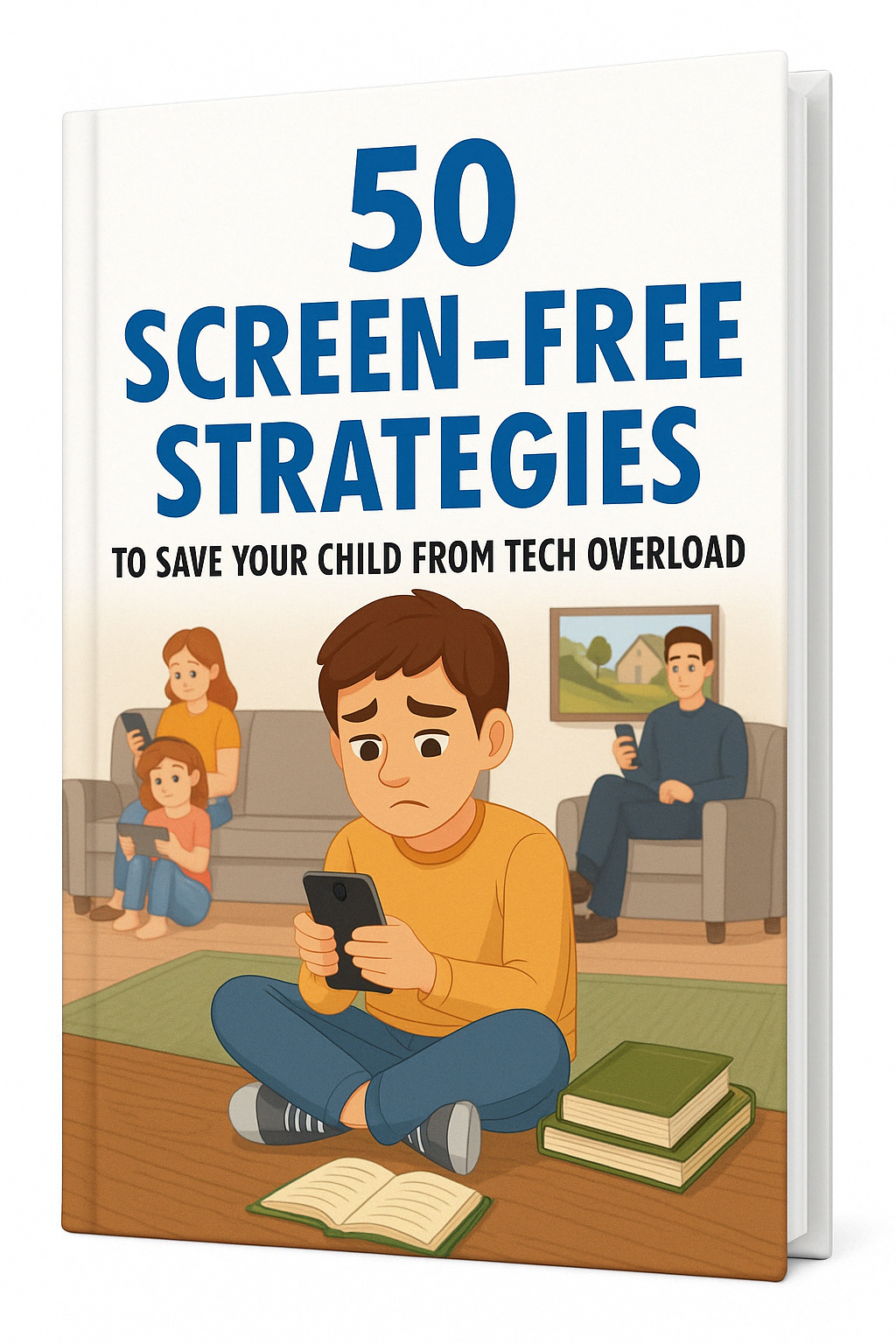
The 50 Screen-Free Swaps Playbook
50 fun and effective alternatives to help your child choose real life over screens.
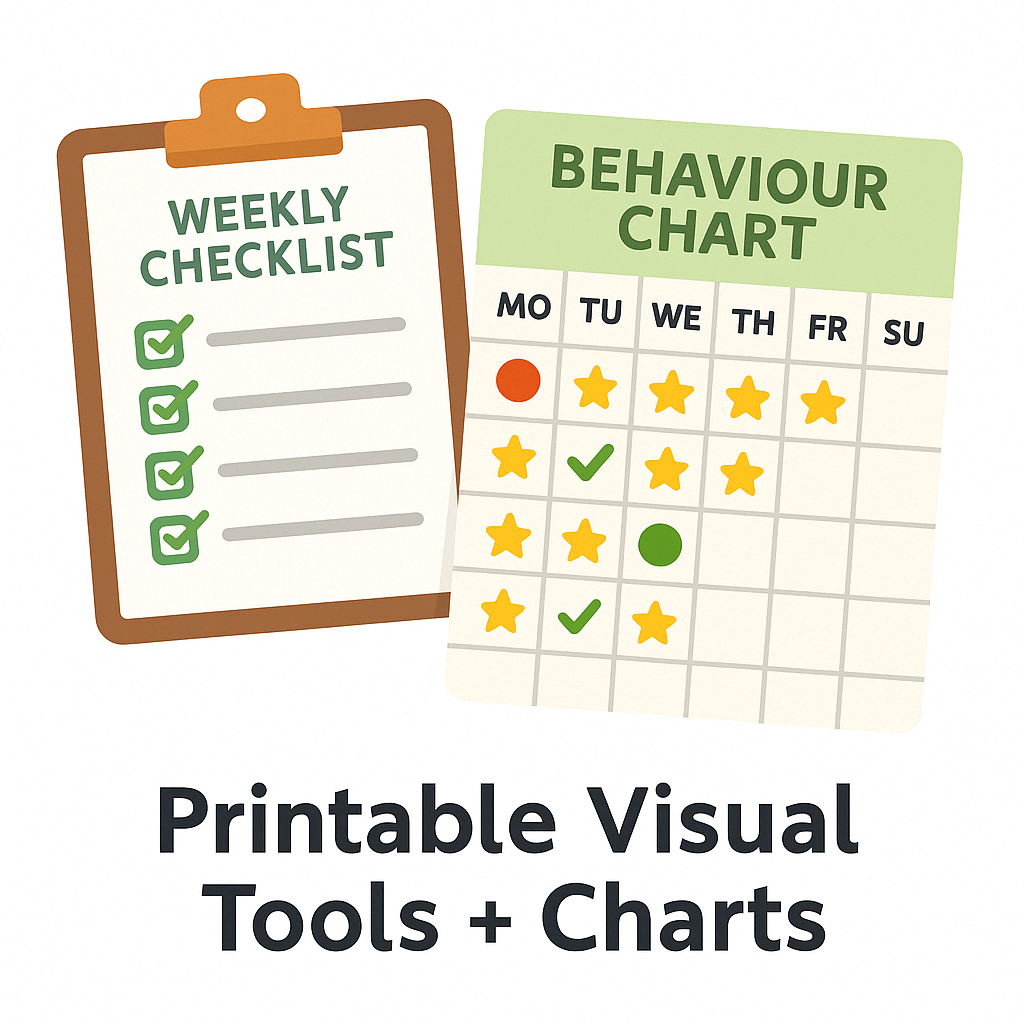
Printable Visual Tools + Charts
Visual agreements, fun behavior charts, and kid-friendly routines you can print.
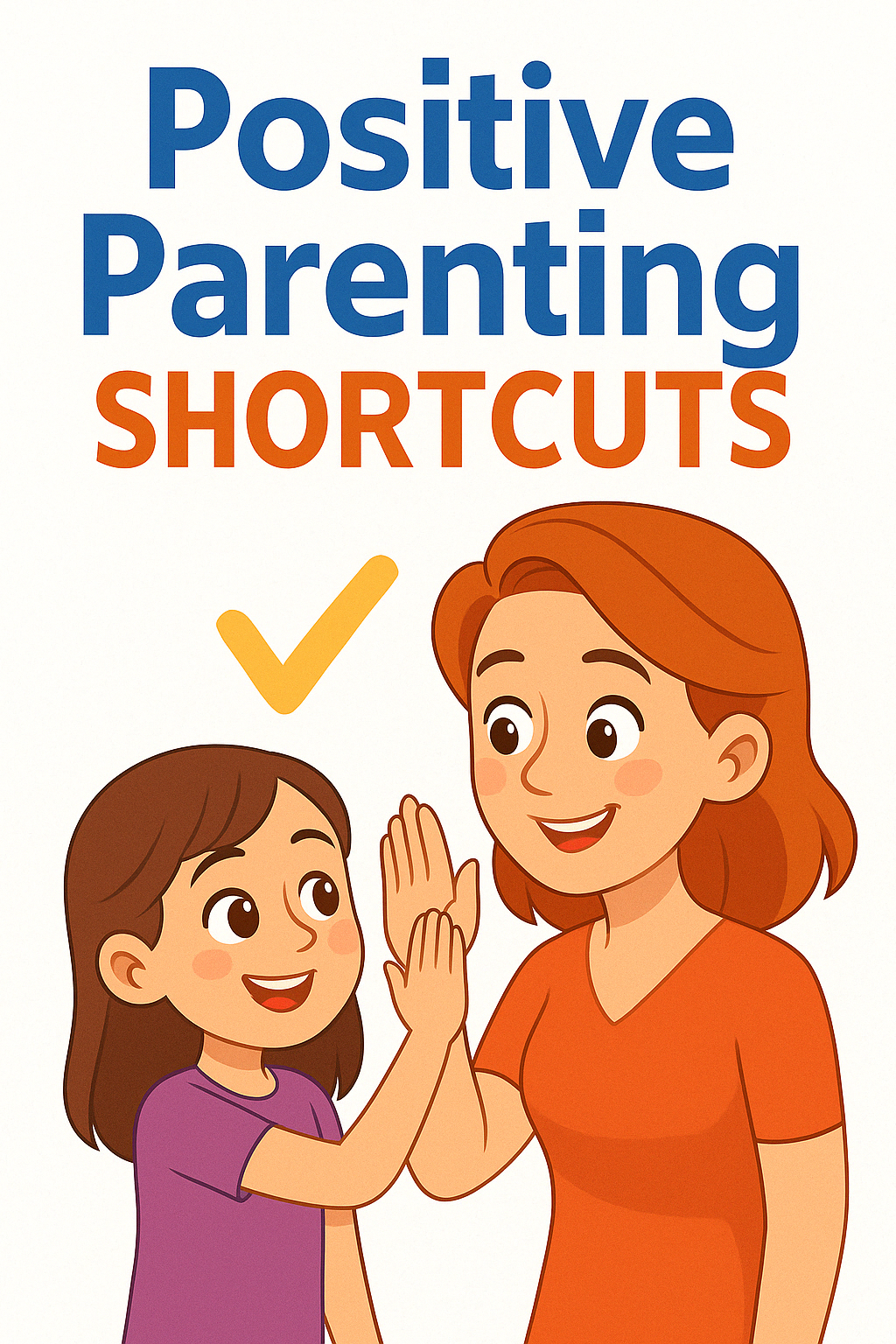
Positive Parenting Shortcuts
Quick techniques to reduce meltdowns, build routines and boost cooperation.

Lifetime Access + Free Updates
Come back anytime, at your own pace. New versions and improvements included.
If you bought everything separately, you’d pay $147 — TODAY, pay just $19.
❗ What Screens Are Doing to Your Child’s Brain — And Science Has Already Proven It
- 📉 A study published in the Journal of the American Medical Association found that children exposed to more than 2 hours of screen time daily showed significantly lower IQ scores than those with limited exposure.
- 🧠 The University of Alberta revealed that excessive screen time is directly linked to language development delays in children under 5.
- ⚠️ The American Academy of Pediatrics warns that constant screen exposure can cause physical changes in brain structures affecting memory, focus, and emotional control.
- 💔 A research with 10,000 teens from the University of San Diego showed that the more time spent on social media, the higher the rates of depression, anxiety, and loneliness.
- 🧬 Brain imaging studies show that the neural pathways of children with screen addiction resemble those of adults addicted to drugs.
👉 That’s why the time to act is NOW.
Every day matters. Every minute counts.
What I Witnessed as a Parent Changed Me Forever
I once saw a 7-year-old child scream at his mother in the middle of a quiet library because she took his tablet away. He flipped a chair and shouted words I won't repeat. Other parents froze. She looked at the ground, embarrassed. Helpless.
In another moment, I watched a little girl — maybe 5 — stare blankly at a screen for hours at a family event. Her cousins were playing, laughing, eating cake. She didn’t even look up. Not once. She was there… but not really.
And then I saw myself.
Handing a phone to my son just to finish a meeting. Giving in during dinner so I could have “ten minutes of peace.” Realizing that, day after day, I was slowly teaching my child to choose a glowing screen over real life.
It wasn’t one big moment. It was the slow erosion of connection… play… joy… curiosity.
That’s when I knew: this isn’t a minor problem. It’s not about “too many cartoons.” It’s something much deeper. And it’s affecting families everywhere — even the ones who seem to have it all together.
What If It Was Never About Entertainment?
What if your child’s obsession with screens wasn’t random? What if the meltdowns, mood swings, and endless scrolling… were part of the plan?
It sounds extreme — until you realize the truth:
🔸 Games don’t pause. 🔸 Videos autoplay. 🔸 Feeds never end. 🔸 Notifications never stop.
These aren’t bugs. They’re features — carefully engineered to keep your child glued to the screen for as long as possible.
The longer they stay, the more ad money flows. And the ones making billions from that attention? They know exactly what they’re doing.
That’s why many of them don’t even allow their own kids to use the devices they create.
It’s like watching someone sell sugar all day and forbid it at home — but worse. Because this doesn’t just rot teeth… it reshapes the brain, rewires emotions, and replaces curiosity with craving.
It’s not your fault. But once you know what’s happening — you can’t unsee it.
And ignoring it is no longer an option.
Why So Many Parents Feel Powerless… And Why It’s Not Your Fault
Most parents don’t realize this, but many of the apps and games your child uses were designed by teams of neuroscientists and behavior engineers — the same kind of experts that help casinos keep people gambling for hours without noticing time pass.
These platforms use color psychology, sound rewards, social triggers, and infinite content loops — all fine-tuned to make your child’s brain crave "just a few more minutes".
And here’s the thing: it works.
That’s why your child gets irritable when the screen goes off. That’s why you have to repeat yourself five times. That’s why “five more minutes” always turns into thirty.
This is not about discipline. This is not about weak parenting. This is about a system that was built to overpower you.
It’s why Dr. Anna Lembke, professor of psychiatry at Stanford, calls this modern wave of digital content "dopamine on demand."
It’s why Dr. Peter Whybrow, director of neuroscience at UCLA, famously warned: “Screens are electronic cocaine for children.”
If you’ve been feeling frustrated, overwhelmed, or even ashamed for not being able to “fix it” — let me tell you something important:
You’re not failing. You’re up against one of the most powerful attention-capturing systems ever created.
And once you understand how it works, you can finally begin to break its grip.

What Screen Time Really Does to a Child’s Brain
Most parents think screen time is just “entertainment.” But here’s what science shows us:
Every time your child plays a fast-paced game, scrolls a video feed, or taps through a digital reward system — their brain releases a powerful chemical called dopamine.
Dopamine is the same chemical released during activities like eating chocolate, falling in love… or using addictive substances.
And when the brain gets flooded with dopamine over and over, it does something dangerous:
It starts to need more and more stimulation to feel the same level of “fun.”
That’s why what started as a 10-minute video becomes a 2-hour binge. That’s why kids get bored with regular toys, frustrated with schoolwork, or irritable in real-life conversations.
It’s not about bad behavior. It’s not about being spoiled.
It’s about a developing brain that’s being trained to crave high-speed rewards — and to avoid anything that feels slow, quiet, or real.
Imagine a treadmill that speeds up every time you take a step — until your child can’t stop running, even when they're exhausted.
That’s what constant screen exposure does inside the brain. And unless we step in… it just keeps accelerating.
It’s Not Just Behavior. It’s Development.
When we think of “too much screen time,” we often picture a child who doesn’t listen, throws tantrums, or gets grumpy when the device is taken away.
But the effects go much deeper — and they often stay hidden until it’s too late.
Clinical studies have linked excessive screen exposure in children to:
- 📉 Delayed language skills and poor communication development
- 🌙 Disrupted sleep patterns and chronic fatigue
- 😟 Increased anxiety and mood swings
- 🧩 Lower attention span and difficulty processing emotions
- 🧠 Weakened memory and cognitive growth
- 💔 Loss of real-life confidence and creativity
One recent study even showed that toddlers who spend more than 2 hours a day in front of a screen develop fewer words, show less emotional expression, and struggle to engage in imaginative play.
It’s not about removing screens forever. It’s about protecting what matters most while their brains — and hearts — are still learning how to grow.
Because every hour glued to a screen… is an hour not spent exploring, asking questions, building confidence, or connecting with you.
And over time, that disconnect becomes a habit — one that many teens carry into adulthood without even realizing what they missed.
The 12 Warning Signs Identified by Experts in Screen Addiction
These aren’t just personality quirks. They’re early red flags that neuroscientists, psychologists, and pediatricians have identified in children who are developing an unhealthy relationship with screens.
- 1. Screens are the first thing they ask for in the morning
Before hugs, before breakfast — it’s “Can I have the iPad?” - 2. Tantrums or mood swings when devices are taken away
You remove the screen… and a meltdown begins. - 3. Refusing to do anything that doesn’t involve a screen
Toys, books, or playing outside just don't compare. - 4. Constant complaints of boredom when offline
If there’s no screen, nothing feels “fun enough.” - 5. Anxiety, restlessness, or aggression when told to stop
You say "Time's up" — and everything changes. - 6. Skipping meals, family time, or sleep to stay online
They stay glued to the screen — even when everyone else has moved on. - 7. Sneaking screens or lying about screen time
You find them hiding under the covers with a device at night. - 8. Trouble focusing on schoolwork or conversations
Homework takes twice as long. Listening feels impossible. - 9. Disinterest in social activities or real-life hobbies
They don’t want to go to the park — they'd rather stay home with YouTube. - 10. Obsession with specific games, apps, or influencers
Every conversation circles back to a character, channel, or challenge. - 11. Using screens as an escape from real emotions
When sad, bored, or angry — they reach for a screen instead of a person. - 12. Becoming irritated, impatient, or numb in real life
The digital world moves fast. Real life feels too slow… or too much.
These signs have been consistently observed in research from institutions like UCLA, Stanford, and the ABCD Study — the largest long-term study of brain development in children in the U.S.
If you’ve noticed even just a few of these signs in your child, this is your opportunity to gently reset their screen habits — before these patterns become harder to reverse.
The Good News: It’s Not Too Late — And You Don’t Need to Do This Alone
If you’ve read this far and felt that tightness in your chest… that quiet voice asking, “Is this happening in my home?” — I want you to know something:
There’s still time. And there’s a way forward.
You don’t need to unplug your family, throw away devices, or become a digital dictator. You just need a clear, practical plan — one that helps you reset your child’s habits, rebuild connection, and bring peace back to your home.
That’s exactly why I created the 21-Day Screen Detox Plan — a step-by-step guide trusted by hundreds of families to gently reduce screen time without fights, punishments, or guilt.
In just three weeks, you can go from overwhelmed to in control — with calmer evenings, more connection, and a child who no longer depends on a screen to feel okay.
And the best part? You won’t have to do it alone. The plan was designed for real families, real challenges, and real life.

A 21-Day Plan to Help Your Child Reconnect With Real Life — and With You
The 21-Day Screen Detox Plan is a gentle, practical path designed to help your child reset screen habits — and for you to reclaim peace, joy, and connection at home.
There’s no yelling. No punishments. No tech bans.
Just a proven, day-by-day process trusted by families just like yours.
In less than a month, you’ll see fewer meltdowns… more imagination… better sleep… and real conversations around the dinner table again.
What You’ll Receive Inside the 21-Day Plan:
- ✅ Daily step-by-step guidance (1 short lesson per day)
- ✅ Creative, screen-free activities your child will actually enjoy
- ✅ Real-life scripts for calm conversations
- ✅ Tools to help your child self-regulate — without force or punishment
- ✅ Lifetime access and free updates forever
You don’t need to figure this out on your own. The plan is here — and it’s helped hundreds of families just like yours.
More Real Stories from Families Just Like Yours

“This plan helped me reconnect with my 7-year-old daughter. I saw changes in just 3 days.”
Jessica M., California
“My son was addicted to his tablet. After 5 days on the plan, he was asking to play outside again.”
Michael T., Texas
“No more fights at bedtime. No more hiding the iPad. This plan brought peace to our home.”
Sophie R., New York
“I was skeptical, but this plan gave me back control without yelling or punishing. It works.”
Carlos D., Florida
“My teen is talking to us again — without the phone in hand. I never thought I’d say that.”
Rachel S., Illinois
“I wish we had found this plan earlier. My kids actually look forward to screen-free time now.”
Brian K., OregonMeet the Team Behind the 21-Day Screen Detox Plan
Created by a team of educators, child development experts, and digital wellness advocates — all passionate about helping families reconnect offline.

Rachel Blake
Parenting Strategist
12+ years helping families build healthier digital habits.

David Greene
Digital Wellness Educator
Former classroom teacher turned screen time reformer.

Emily Chen
Child Behavior Specialist
M.S. in Child Psychology & mom of two screen-free kids.
You're Protected by Our 90-Day Money-Back Guarantee
If you don't see positive changes in your child's relationship with screens, you’ll get 100% of your money back. No questions asked.

This Is Everything You’ll Get When You Join Today


Bonus 1: Real-Life Scripts for Calm Conversations – Learn exactly what to say (and how) when your child resists limits.

Bonus 2: 50 Creative Activities for Screen-Free Days – Replace boredom with imagination and fun.

Bonus 3: Printable Visual Tools + Charts – Use fun trackers and visual aids to support your child’s progress.

Bonus 4: Positive Parenting Shortcuts – Quick tools to create calmer routines and more cooperation.

Bonus 5: Lifetime Access + Free Updates – Get future updates and access your plan anytime.
Get the full program + all 5 bonuses today for only $19
Get Instant Access NowStill Have Questions? We’ve Got Answers.
Absolutely. The plan was created for parents of kids between 3 and 17 years old. It’s flexible and adapts to different ages and developmental stages — from toddlers to teens.
What if I can’t follow the plan every single day?
That’s okay! Life is messy. You’ll have lifetime access to all content, so you can move at your own pace — and come back anytime.
Is it really just $19 for everything?
Yes — no tricks, no monthly charges. One payment of $19 gives you access to the full 21-day plan plus all 5 high-value bonuses.
How will I receive the content?
Everything is delivered directly to your email. You’ll get instant access to all materials, including daily lessons and downloadable bonuses.
What if I’m not satisfied with the results?
We’re confident you’ll love it — but if not, you’re protected by our 90-day money-back guarantee. Just send us a message, and we’ll refund you.
Do I need to print anything?
Only if you want to. All tools can be used digitally, but we also provide printable charts and visual aids in PDF format — ready if you prefer paper.
é orgulhosamente mantido com WordPress
